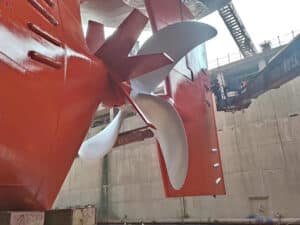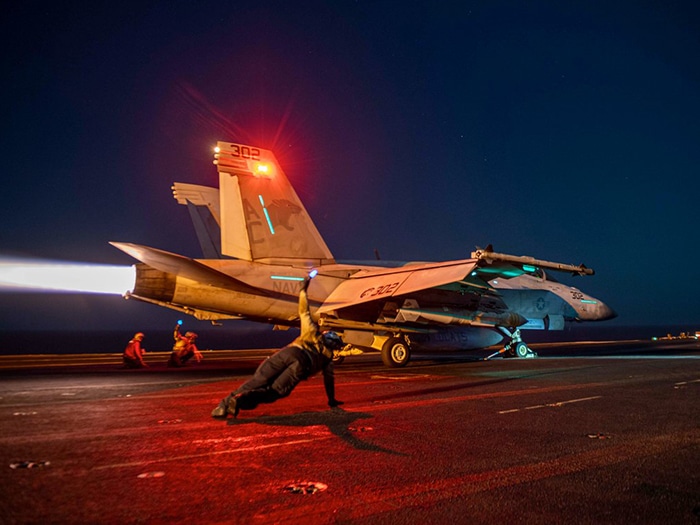
New Houthi targets pounded after attack on TSP tanker Torm Tor
Written by Nick Blenkey
Image: CENTCOM
The U.S. and the U.K. on Saturday launched a fresh wave of attacks on Houthi targets in Yemen after the Iranian-backed terrorist organization continued its attacks on shipping in the Red Sea. Among the most recent reported by U.S. Central Command was a February 24 incident that saw the USS Mason (DDG 87) shoot down one Anti-Ship Ballistic Missile (ASBM) launched into the Gulf of Aden from Iranian-backed Houthi controlled areas of Yemen. CENTCOM says the missile was likely targeting MV Torm Thor, a U.S.-flagged, owned, and operated chemical/oil tanker. Neither USS Mason nor the Torm Thor were damaged and there were no injuries.
Torm Thor, which is operated by Fort Lauderdale, Fla., based Seabulk Tankers Inc., was reflagged as a U.S.-flag vessel last November after SEACOR subsidiary Seabulk Tankers partnered with Denmark’s Torm to provide three ships for MARAD’s new Tanker Security Program.
The fresh round of attacks on Houthi targets began later that same day when, at approximately 11:50 p.m. (Sanaa Yemen time), U.S. Central Command forces alongside UK Armed Forces, and with support from Australia, Bahrain, Canada, Denmark, the Netherlands, and New Zealand, conducted strikes against 18 Houthi targets in Iranian-backed Houthi terrorist-controlled areas of Yemen.
CENTCOM says the strikes from the multilateral coalition targeted areas used by the Houthis to attack international merchant vessels and naval ships in the region. Illegal Houthi attacks have disrupted humanitarian aid bound for Yemen, harmed Middle Eastern economies, and caused environmental damage.
The targets included Houthi underground weapons storage facilities, missile storage facilities, one-way attack unmanned aerial systems, air defense systems, radars, and a helicopter. These strikes are intended to degrade Houthi capability and disrupt their continued reckless and unlawful attacks on international commercial and U.S. and U.K. vessels in the Red Sea, Bab AI-Mandeb Strait, and the Gulf of Aden.
The fresh round of attacks on Houthi targets began later that same day when, at approximately 11:50 p.m. (Sanaa Yemen time), U.S. Central Command forces alongside U.K, Armed Forces, and with support from Australia, Bahrain, Canada, Denmark, the Netherlands, and New Zealand, conducted strikes against 18 Houthi targets in Iranian-backed Houthi terrorist-controlled areas of Yemen.
CENTCOM says the strikes from the multilateral coalition targeted areas used by the Houthis to attack international merchant vessels and naval ships in the region. Illegal Houthi attacks have disrupted humanitarian aid bound for Yemen, harmed Middle Eastern economies, and caused environmental damage.
The targets included Houthi underground weapons storage facilities, missile storage facilities, one-way attack unmanned aerial systems, air defense systems, radars, and a helicopter. These strikes are intended to degrade Houthi capability and disrupt their continued reckless and unlawful attacks on international commercial and U.S. and U.K. vessels in the Red Sea, Bab AI-Mandeb Strait, and the Gulf of Aden.
A Joint Statement from Australia, Bahrain, Denmark, Canada, the Netherlands, New Zealand, the U.K. and the U.S. noted that the strikes were “in response to Houthis’ continued attacks against commercial and naval vessels that have not only endangered international seafarers but the lives of the Yemeni people, including the February 22 missile attack that struck the United Kingdom-owned M/V Islander and injured a crewmember, the February 19 missile attack that nearly struck the U.S.-owned M/V Sea Champion while delivering humanitarian aid to Yemen, the February 19 UAV attack that struck the U.S.-owned M/V Navis Fortuna, and the February 18 missile attack that struck the United Kingdom-owned M/V Rubymar and forced the crew to abandon the ship.”
The Rubymar is anchored but slowly taking on water. The Houthi attack caused significant damage to the ship, resulting in an 18-mile oil slick. The vessel was transporting over 41,000 tons of fertilizer when it was attacked, which could spill into the Red Sea and worsen the environmental disaster, threatening the fishing industry and coastal communities, and imports of food supplies.




